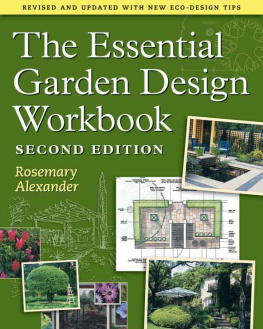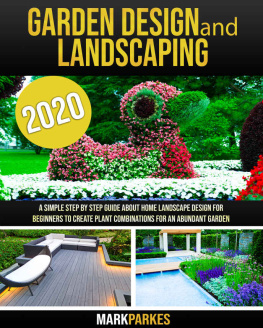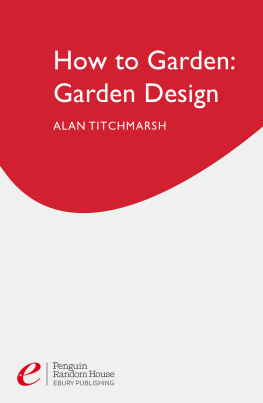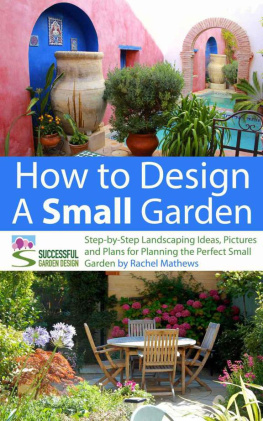The Essential Garden Design Workbook
The Essential Garden Design Workbook
Rosemary Alexander
Second Edition
Revised and Updated with New Eco-Design Tips

Copyright 2009 by Rosemary Alexander. All rights reserved.
All photographs by Rosemary Alexander.
All illustrations by Joseph Kent except those appearing on pages by Roger Sweetinburgh.
Mood boards and designs by Rochelle Greayer (page ).
Published in 2009 by Timber Press, Inc. |
The Haseltine Building | 2 The Quadrant |
133 S.W. Second Avenue, Suite 450 | 135 Salusbury Road |
Portland, Oregon 97204-3527 | London NW6 6RJ |
www.timberpress.com | www.timberpress.co.uk |
ISBN-13: 978-0-88192-975-1
Second printing 2010
Designed by Dick Malt
Printed in China
Catalogue records for this book are available from the Library of Congress and the British Library.
Contents
Acknowledgements
Writing and updating a design manual is often a partnership. As with the previous edition, I have been able to draw on a very talented team.
Firstly my thanks go to Anthony du Gard Pasley, whose vast experience and discerning eye taught me so much in the formative years of The English Gardening School, and who made a great contribution to the original text. My thanks, secondly, to my editor, Anna Mumford, whose encouragement and tenacity greatly improved the first edition and now to Erica Gordon-Mallin, who encouraged me to bring the book up to date with the latest garden design developments. I am indebted to Susanne Haines, project editor of the first edition, for her valuable work and to Dick Malt for the excellent design. My thanks also to Joe Kent, Carel Lucas and especially to Roger Sweetinburgh, who were invaluable in providing the line drawings and chapter plans; to Rochelle Greayer for advice on the American perspective; to Rochelle Greayer, Sarah Haigh and Rachel Myers for allowing me to show their plans; to Amanda Crabb for her invaluable and reliable support and for giving some semblance of order to my erratic computer skills; and to Barbara Linton for her patience and experience in dealing with the original plans and drawings.
And above all I am grateful to past, present and future students of garden design worldwide, whose enthusiasm and encouragement motivates me to share and expand my knowledge.
There is more pleasure in making a garden than in contemplating a paradise.
Anne Scott-James
Introduction
Introduction
Since the first edition of this book was published in 2004, our approach to garden design has changed in several essential ways. While creating beautiful and thoroughly enjoyable spaces remains top priority, our growing concern for saving the planet for future generations has made many of us think carefully about what we do with our homes and gardens.
Drawing upon the very latest eco-friendly methods of sensitive design, planting and sustainability can make our gardens, and the experience of working in them, far more rewarding. For instance, we can use recycled household water instead of irrigation systems, seek out permeable and sustainable materials, and encourage wildlife to enhance our gardens ecosystems. To this end I have added new information, easy-to-follow illustrations and inspirational photographs to show how innovations such as green roofs or rainwater harvesting systems can be constructed, how gardens and planting have been adapted to the challenging bio-diverse conditions that now concern us, and much more.
Garden design is all about organizing and shaping spaces, and in this respect it is closely related to architecture. It covers many different elements, beginning with surveying the site and understanding the soil and the climate, through to selecting the plants, ornaments and lighting. Because it encompasses so many different disciplines, it is also one of the most complex art forms. But just as someone can be taught how to paint, anyone who is new to garden design can be taught how to make a beautiful garden.
Most of what I have written is based on what I practise in the garden and teach in the classroom. Whether you are starting from scratch or revamping a neglected, overgrown or outdated site, my aim is to take you logically through the various stages of planning a garden. It is a process that begins with assessing the site, the soil and the surroundings and involves everything from this initial survey through to constructing pergolas and terraces, using water wisely, choosing plants and placing them to best effect.
Factors to Consider
To be a good designer, two qualities are essential: firstly the ability to see things clearly and to understand their intrinsic nature, and secondly the ability to analyze the value of what is seen, identifying good and bad points and deciding how best they may be used or concealed. For the professional designer, identifying what is wanted in possible and practical terms results from collaboration with the owners.
Gardens are for people as well as plants, and the space must be comfortable and appropriate for both. Family needs evolve as children grow up, or as the owners find they have less time or energy. A garden should enhance the lives of those who use it, without imposing a stressful burden; it is crucial to understand how much maintenance can realistically be devoted to the garden before beginning the design process. Once you have thoroughly consulted with the owners, take time to consider your new ideas, experimenting with different styles or themes until you find a suitable and workable scheme.
Cost may also be a critical factor. Fortunately, using recycling existing or local materials is cost-effective as well as eco-friendly. Legal constraints now imposed by many civic authorities require the use of permeable and sustainable materials, and in many countries scarcity of water has affected what can be grown.
Choosing the plants is usually the most exciting part of designing a new garden, but it is also the most exacting. Plants have their individual preferences, and it is crucial that you select those that will thrive in your locality. When using plant material, the scene is constantly evolving as the plants shapes, colours and textures mature or respond to seasonal changes. This book will show you how to choose, combine and arrange plants to create a display suited to your gardens climate and soil conditions.
Stages in the Design Process
In order to effectively explain and develop your design, it is vital that you present your ideas on paper. This book takes you step-by-step through the process, with a sequence of plans for a large suburban garden providing drawn examples of how a site develops through the various stages. You need not be artistic to draw up a presentable plan; in this book I go back to basics, explaining which drawing materials are needed and how to use them, showing you how to draw a plan to scale and, finally, describing how to create other backup or presentation material, such as details, visuals and mood boards. Very encouraging results can be achieved with no previous drawing experience.
Designing a garden is a gradual process, and the sample plans shown throughout the book chart the different stages. The site survey, site inventory and site appraisal are the first drawings made during the research and preparation phase. In researching them and drawing them up you will become familiar with the advantages and constraints of the site. Concept diagrams illustrate options for reorganizing the site to fulfil your needs.










